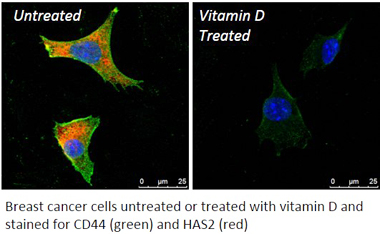UAlbany Researcher Explores Link Between Vitamin D, Breast Cancer Treatment
Empire Innovations Professor JoEllen Welsh Receives $1.76 Million Grant from NIH to Examine Role of Vitamin D in Triple Negative Breast Cancer Suppression
ALBANY, N.Y. (June 4, 2015) -- Each year, about 230,000 new cases of breast cancer are diagnosed in women in the U.S. It remains the third leading cause of death, behind only heart disease and lung cancer. Of the new cases, about 20 percent of women will be diagnosed with "triple negative" breast cancer (TNBC), a deadly form of breast cancer that does not respond to standard treatments such as tamoxifen or aromatase inhibitors.
TNBC is a subtype of breast cancer that lacks three important receptors that are used as targets for cancer treatment: estrogen, progesterone receptors, or human epidermal growth factor receptor 2 (HER2). This indicates that TNBC is not supported by the hormones or other factors known to trigger growth of other forms of breast cancer. Because of these challenges, there is an intense interest by doctors and researchers to develop medications to treat TNBC.
University at Albany Empire Innovations Professor JoEllen Welsh and her team at the Cancer Research Center (CRC) are among those working toward developing therapies that will be successful in halting TNBC. To aid in their efforts, Dr. Welsh has received a $1.76 million grant from the National Institutes of Health's National Cancer Institute to explore the role of vitamin D in TNBC.
 |
|
Courtesy Cancer Research Center |
Welsh and her team have discovered that 1,25D – the active form of vitamin D, suppresses the expression and activity of hyaluronan synthase-2 (HAS2), a gene that is overexpressed in a subset of TNBC tumors. HAS2 encodes an enzyme that produces hyaluronic acid (HA), a secreted polymer that activates the cell surface receptor CD44. The receptor CD44 has been functionally associated with the "tumor initiating cell" properties in TNBC. Essentially, with considerable evidence suggesting TNBCs are dependent on CD44 for survival, finding a way to suppress or interrupt the signaling process holds promise for treatment.
"Women with TNBC whose tumors overexpress HAS2 have a significantly reduced survival, suggesting that targeting this gene is likely to have an impact on disease progression," said Welsh, a professor of environmental health sciences at UAlbany's School of Public Health. "Our preliminary data strongly suggests that vitamin D suppression of HAS2 activity and HA synthesis represents a feasible approach for interrupting the CD44 signaling process in TNBC cells."
Welsh and her team plan to examine the independent and interactive effects of vitamin D and other natural products on HA metabolism and CD44 signaling in TNBC models. Her team hopes that if pre-clinical studies demonstrate that any or all of the agents impact disease progression, then measuring the biochemical levels of HA metabolism could become a useful screen to identify breast cancer patients who are most likely to respond to these interventions.
Welsh, an expert in steroid hormones, nuclear receptors and breast cancer, is internationally recognized as the prominent researcher in the area of Vitamin D and breast cancer. For more information on Dr. Welsh’s current research projects, visit here.
The Cancer Research Center is located on the University at Albany's East Campus, the biotech hub of the University's life sciences research endeavor and a mixed-purpose facility with a dynamic environment for synthesizing the University's educational, scientific, and economic development capabilities with industry and other research institutions. The 87-acre complex is anchored by the University's School of Public Health, and offers more than 350,000 square feet of lab space and associated support and office space.
![]() For more news, subscribe to UAlbany's RSS headline feeds
For more news, subscribe to UAlbany's RSS headline feeds
A comprehensive public research university, the University at Albany-SUNY offers more than 120 undergraduate majors and minors and 125 master's, doctoral and graduate certificate programs. UAlbany is a leader among all New York State colleges and universities in such diverse fields as atmospheric and environmental sciences, business, education, public health,health sciences, criminal justice, emergency preparedness, engineering and applied sciences, informatics, public administration, social welfare and sociology, taught by an extensive roster of faculty experts. It also offers expanded academic and research opportunities for students through an affiliation with Albany Law School. With a curriculum enhanced by 600 study-abroad opportunities, UAlbany launches great careers.


